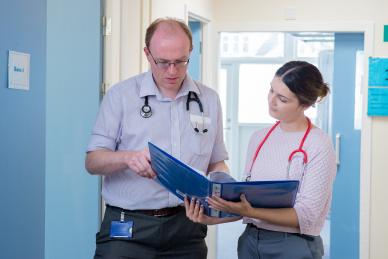Listen to our CPT Podcast Episode
In Career Conversations, Dr David Ryan talks to Prof Emma Baker and Dr Dipender Gill about a career in Clinical Pharmacology.
Empowering medical excellence, shaping healthcare futures.
The day is varied, exciting and creative. In addition to the GIM responsibilities, one of the main advantages of CPT is the autonomy with which you can direct your training to suit your interests. Examples of activities in CPT include:
Clinical: Areas of interest include clinical toxicology, from self-poisoning to biochemical terrorism, cardiovascular risk including hypertension, stroke disease
Research: Learn about setting up and running clinical trials and developing skills in bench to bedside translational research
Teaching: Many CPT trainees take on responsibilities in under- and postgraduate teaching
Medicine regulation: Training in CPT provides the opportunity to develop an interest in the regulation of medicines and prescribing through drug and therapeutics committees, regional prescribing groups and the National Institute for Health and Clinical Excellence (NICE)


Dr Linsay McCallum
Definition of CPT from author:
"A creative, flexible specialty, nurturing a wide generalist interest across therapeutics, toxicology, clinical research, medical education and drug regulation."

Self-driven, creative, flexible training with excellent exposure to clinical, research, teaching and governance
Due to the autonomous nature of training, there is no fixed career path (although most people in the specialty think this is an advantage)
Be enthusiastic about general medicine, teaching and research and maintain a broad interest
Commonly, a four-year post gaining dual accreditation in CPT and General Internal Medicine (GIM), though it is a flexible specialty well-suited to dual accrediting with others.
Entry requirements to apply for CPT training include completion of the MRCP. There is no final specialty exam in CPT at present but as is increasingly the case in other specialties, an exit exam may be introduced in the last year of training before Certificate of Completion of Training (CCT) in CPT.
Completion of CPT specialty training curriculum with successful ARCP outcome.
Due to the flexibility of the training programme, CPT is well-suited for taking time out of programme (OOP). It is anticipated that in pursuing the advanced research module, trainees would consider using this as the first stage in undertaking a postgraduate research degree. By the time they achieve a CCT, almost all trainees will also have an advanced degree.

In Career Conversations, Dr David Ryan talks to Prof Emma Baker and Dr Dipender Gill about a career in Clinical Pharmacology.